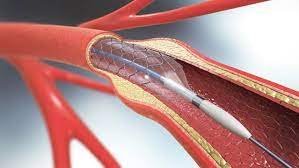Coronary Angiography & Angioplasty [Stenting] including Primary & Complex PCI
Overview
Coronary angiography and angioplasty, including primary and complex percutaneous coronary intervention (PCI), are medical procedures performed to diagnose and treat coronary artery disease (CAD), a condition where the blood vessels supplying the heart muscle (coronary arteries) become narrowed or blocked.
Coronary Angiography
- Purpose: Coronary angiography is a diagnostic procedure that involves imaging the coronary arteries to identify any blockages or narrowing.
- Procedure: A catheter (thin tube) is threaded through the blood vessels, usually from the groin or wrist, to the coronary arteries. Contrast dye is injected, and X-ray images (angiograms) are taken to visualize blood flow and detect any abnormalities.
Angioplasty (Percutaneous Coronary Intervention – PCI)
- Purpose: Angioplasty is a therapeutic procedure used to open narrowed or blocked coronary arteries to restore blood flow to the heart muscle.
- Procedure:
A catheter with a deflated balloon is advanced to the site of the blockage. The balloon is inflated to compress the plaque against the artery walls, widening the vessel and improving blood flow. In many cases, a stent is placed during angioplasty to help keep the artery open.
Stenting:
- Purpose: Stenting is often performed in conjunction with angioplasty to maintain the widened coronary artery.
- Procedure:
A stent (a small mesh-like tube) is placed over the balloon on the catheter. When the balloon is inflated, the stent expands, pushing against the vessel walls and holding them open. The stent remains in place permanently to provide ongoing support to the artery.
Primary PCI
- Definition: Primary PCI refers to percutaneous coronary intervention performed as an emergency treatment for individuals experiencing a heart attack (myocardial infarction).
- Timing: It is done as quickly as possible after the onset of symptoms to restore blood flow to the blocked artery and minimize damage to the heart muscle.
Complex PCI
- Definition: Complex PCI involves procedures that are more challenging due to factors such as multiple blockages, heavily calcified lesions, or anatomical complexities.
- Challenges: Complex PCI may require advanced techniques, specialized equipment, and the expertise of interventional cardiologists experienced in handling intricate cases.




Contact Us
- +918530797300
- theheartclinic77@gmail.com
- The Heart Clinic, 302, 3rd floor, Ganesham Commercial, E- Building, Near Govind Garden Hotel, Pimple Saudagar, Pune 411027.
Quick Link
Menu
Copyright © 2024 Vivek Manade All rights reserved. Powered by Edgelink Technology